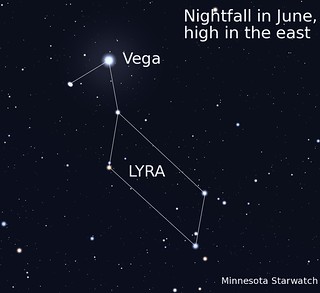Northern Sky - Deane Morrison June 8 - 21
NORTHERN SKY
by Deane Morrison
June 8-21 2019
In the second two weeks of June, planets and stars are on the move. But the sun seems to be standing still, as it always does for about two months around each solstice, a word that literally means “sun standing still.” The summer solstice arrives at 10:54 a.m. on Friday, the 21st. At that moment, the sun will be over the Tropic of Cancer, and an observer in space would see the Earth lighted from the Antarctic Circle up to the North Pole, then beyond to the Arctic Circle on the dark side of our planet.
In the west, Mercury has popped into the evening sky. Mercury never gets very high, but if you look at nightfall from night to night, with binoculars if necessary, you may be able to see it climb away from the west-northwestern horizon. It heads straight for Mars, which is extremely dim, and on the 18th it passes only about half a moon width above the red planet. Above and to the right of the planets are the Gemini twins Pollux, the brighter one, and Castor. After their close encounter, Mars and Mercury go their separate ways. And all these objects get lost in the sunset by the end of June.
On the 10th, we lap Jupiter in the orbital race. At this moment Jupiter is said to be at opposition, because it’s on the opposite side of Earth from the sun and thus opposite the sun in the sky. At opposition, an outer planet rises around sunset and stays up all night. Jupiter is a brilliant beacon, and it rises in the southeast right behind the constellation Scorpius. The scorpion’s heart is Antares, a gigantic red star a little below and west of Jupiter. Saturn follows Jupiter into the sky by about two hours.
The evening of the 15th, a bright waxing moon appears between and above Jupiter and Antares. The evening of the 18th, a bright waning moon rises right below Saturn. For the next several days, Jupiter and Saturn get to shine against a darker sky at nightfall because the moon rises later each night while they rise earlier.
In the east, look for the Summer Triangle of bright stars. The brightest is Vega, in the constellation Lyra, the lyre of the mythical Greek musician Orpheus. With binoculars you can easily see the parallelogram of stars that outline the body of the lyre. Vega is only about 25 light-years away, and it has a great claim to fame, thanks to Earth’s habit of wobbling on its axis like a top. This wobbling makes the North Pole point to different stars in sequence as it traces out a circle every 26,000 years. The North Pole now points toward Polaris, but once it pointed toward Vega, and in about 12,000 more years, Vega will again be the north star.
When the sky gets dark, Vega and Jupiter form a big, bright triangle with the brilliant star Arcturus, in Bootes, the herdsman. Arcturus is west of Vega and marginally brighter. Grab a star map and look between Vega and Arcturus. Next to Vega is the upside-down form of Hercules, and next to Hercules is a semicircle of stars called Corona Borealis, the northern crown.
The night of the 16th to 17th, the moon takes a low trajectory across the night sky and reaches fullness at 3:31 a.m. The low trajectory happens because a full moon is always opposite the sun in the sky. Therefore, when we’re this close to the summer solstice and our hemisphere is tilting strongly toward the sun, it must also tilt away from a full moon, leaving it low in the sky.
Deane Morrison writes the Minnesota Starwatch column for the University of Minnesota’s Minnesota Institute for Astrophysics.
Tweet




